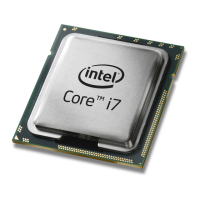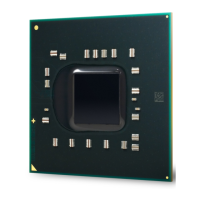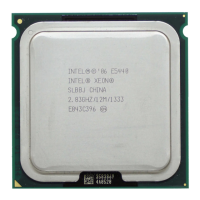Datasheet, Volume 1 41
Technologies
3.4 Intel
®
Turbo Boost Technology
Compared with previous generation products, Intel Turbo Boost Technology will
increase the ratio of application power to TDP. Thus, thermal solutions and platform
cooling that are designed to less than thermal design guidance might experience
thermal and performance issues since more applications will tend to run at the
maximum power limit for significant periods of time.
Note: Intel Turbo Boost Technology may not be available on all SKUs.
Intel Turbo Boost Technology is a feature that allows the processor to opportunistically
and automatically run faster than its rated operating core and/or render clock
frequency when there is sufficient power headroom, and the product is within specified
temperature and current limits. The Intel Turbo Boost Technology feature is designed to
increase performance of both multi-threaded and single-threaded workloads. The
processor supports a Turbo mode where the processor can use the thermal capacity
associated with package and run at power levels higher than TDP power for short
durations. This improves the system responsiveness for short, bursty usage conditions.
The turbo feature needs to be properly enabled by BIOS for the processor to operate
with maximum performance. Since the turbo feature is configurable and dependent on
many platform design limits outside of the processor control, the maximum
performance cannot be ensured.
Turbo Mode availability is independent of the number of active cores; however, the
Turbo Mode frequency is dynamic and dependent on the instantaneous application
power load, the number of active cores, user configurable settings, operating
environment, and system design.
3.4.1 Intel
®
Turbo Boost Technology Frequency
The processor's rated frequency assumes that all execution cores are active and are at
the sustained thermal design power (TDP). However, under typical operation not all
cores are active or at executing a high power workload. Therefore, most applications
are consuming less than the TDP at the rated frequency. Intel Turbo Boost Technology
takes advantage of the available TDP headroom and active cores are able to increase
their operating frequency.
To determine the highest performance frequency amongst active cores, the processor
takes the following into consideration to recalculate turbo frequency during runtime:
• The number of cores operating in the C0 state.
• The estimated core current consumption.
• The estimated package prior and present power consumption.
• The package temperature.
Any of these factors can affect the maximum frequency for a given workload. If the
power, current, or thermal limit is reached, the processor will automatically reduce the
frequency to stay with its TDP limit.
Note: Intel Turbo Technology processor frequencies are only active if the operating system is
requesting the P0 state. For more information on P-states and C-states refer to
Chapter 4, “Power Management”.

